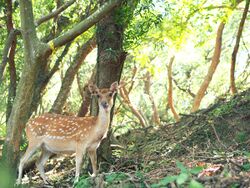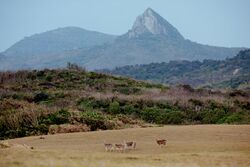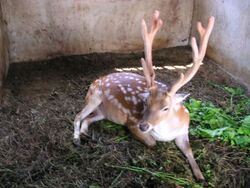Biology:Formosan sika deer
| Formosan sika deer | |
|---|---|

| |
| Formosan sika deer on Daqiu Island | |
| Scientific classification | |
| Domain: | Eukaryota |
| Kingdom: | Animalia |
| Phylum: | Chordata |
| Class: | Mammalia |
| Order: | Artiodactyla |
| Family: | Cervidae |
| Subfamily: | Cervinae |
| Genus: | Cervus |
| Species: | |
| Subspecies: | C. n. taiouanus
|
| Trinomial name | |
| Cervus nippon taiouanus Blyth, 1860
| |
The Formosan sika deer (Chinese: 台灣梅花鹿; pinyin: Táiwān méihuālù; Pe̍h-ōe-jī: Tâi-oân hoe-lo̍k) (Cervus nippon taiouanus) is a subspecies of sika deer endemic to the island of Taiwan. Formosan sika, like most of the terrestrial fauna and flora of Taiwan, arrived on the island during Pleistocene glacial periods when lower sea levels connected Taiwan to the Asian mainland.
Appearance and behavior
Sika stand 90–120 cm at the shoulder, 155 cm in length, 43 - 68 kg in weight.[1] Males are larger and bear deciduous antlers. The summer coat is light brownish, with obvious white spots, while in winter their coat is darker and the spots fade.
Range and habitat
The natural distribution of sika on Taiwan was in the woodlands from sea level up to about 300 meters elevation. Sika, like many deer, prefer areas of mixed forest, scrub, and open land. Under natural conditions the low-lying alluvial plain that stretches from present-day Taipei along the west coast almost to the southern tip of the island were prime deer habitat and natural populations would have been quite dense.
Status
Sika populations in Taiwan have been heavily influenced by human activity for the past four hundred years. Until the early 17th century the human population of Taiwan was low and comprised mostly Austronesian peoples who had been living on the island for thousands of years. During the 17th century immigration from the Chinese mainland increased dramatically in response to political instability in China and economic opportunities on Taiwan, which from 1624 until 1662 was controlled by the Dutch East India Company (VOC). The VOC, operating from the port of Taoyuan (modern-day Anping, Tainan) in southwestern Taiwan, established a trading post whose main business was the export of sika skins to neighboring Asia. During the six decades of Dutch activity two to four million sika skins were exported to China and Japan.[2][3] Exporting was reduced when the Dutch were forced out of Taiwan in 1662, but continued throughout the Qing period with a switch to Japan as the major export market.[4]
The intensive hunting of sika during the Dutch era must have severely decreased the population of sika. Sika populations continued to decline over the next few centuries as the human population expanded—the natural habitat of sika in the lowland plains was steadily converted to farmland, and later urbanized, as the human population increased. Hunting also continued. As a result, wild sika populations decreased steadily, and in 1969 the last known wild sika was killed.[5]
However, deer are easily kept in captivity and there were a number of captive populations of C. n. taiouanus. In 1984 Taiwan’s Council of Agriculture funded the Sika Deer Reintroduction Project, based at Kenting National Park on the southern tip of the island. Twenty-two deer were transferred from the Taipei Zoo to serve as a founder population. Over the next 10 years the deer were maintained in enclosures until their eventual release into the National Park in 1994. Altogether over 200 deer have been released and the current population, now spread beyond the park borders, is estimated to exceed 1000 individuals.[6] Discussions regarding other possible reintroduction sites, including Yangmingshan National Park near Taipei, are ongoing. Daqiu Island, Beigan Township, Lienchiang County (the Matsu Islands) is known for its population of Formosan sika deer introduced in the 1990s.[7][8]
See also
References
- ↑ "The Plight of the Formosan Sika Deer". https://en.wildatheart.org.tw/story/109/6822.
- ↑ 江樹生。 1985。梅花鹿與台灣早期歷史關係之研究, 第3–62頁。台灣梅花鹿復育之研究七十四年度報告。內政部營建署墾丁國家公園管理處
- ↑ Davidson, James W. (1903). The Island of Formosa, Past and Present : history, people, resources, and commercial prospects : tea, camphor, sugar, gold, coal, sulphur, economical plants, and other productions. London and New York: Macmillan & co.. https://archive.org/details/islandofformosap00davi.
- ↑ The Plight of the Formosan Sika. wildatheart.org.tw
- ↑ McCullough, D. R. 1974. Status of Larger Mammals in Taiwan. Taipei: Tourism Bureau
- ↑ 墾丁社頂生態遊 梅花鹿見客 | 台灣環境資訊協會-環境資訊中心. E-info.org.tw (2010-06-30). Retrieved on 2012-08-23.
- ↑ "Daqiu". https://www.matsu-nsa.gov.tw/user/Attraction-Content.aspx?a=60&l=2. Retrieved 28 August 2019. "In the past, it has been both home to civilians and a post for the military, but with the migration of the residential population and the pullout of the Armed Forces, Daqiu has become the largest uninhabited island in Mazu which may be visited. In recent years, with the restoration of the footpath around the island and the successful breeding of the Formosan sika deer(Cervus nippon taiouanus) has turned the island a deer-watching paradise; if you arrive on Daqiu early in the morning, there's a good chance you'll see the beautiful sika deer."
- ↑ "Matsu Island opens doors to tourists". 30 March 2010. https://taiwantoday.tw/news.php?unit=10,23,45,10&post=16486. Retrieved 28 August 2019. "The Formosan sika deer that currently roam the deserted Daqiu Island are also noteworthy, Gu said, adding that his administration will soon build pavements that will enable tourists to get close to the deer."
External links
Wikidata ☰ Q3847157 entry
 |



